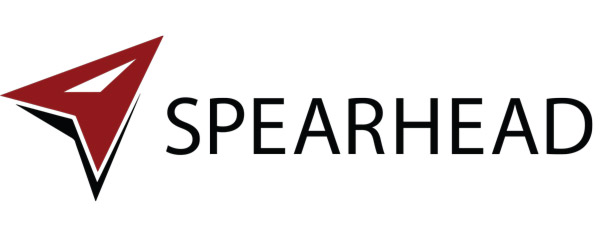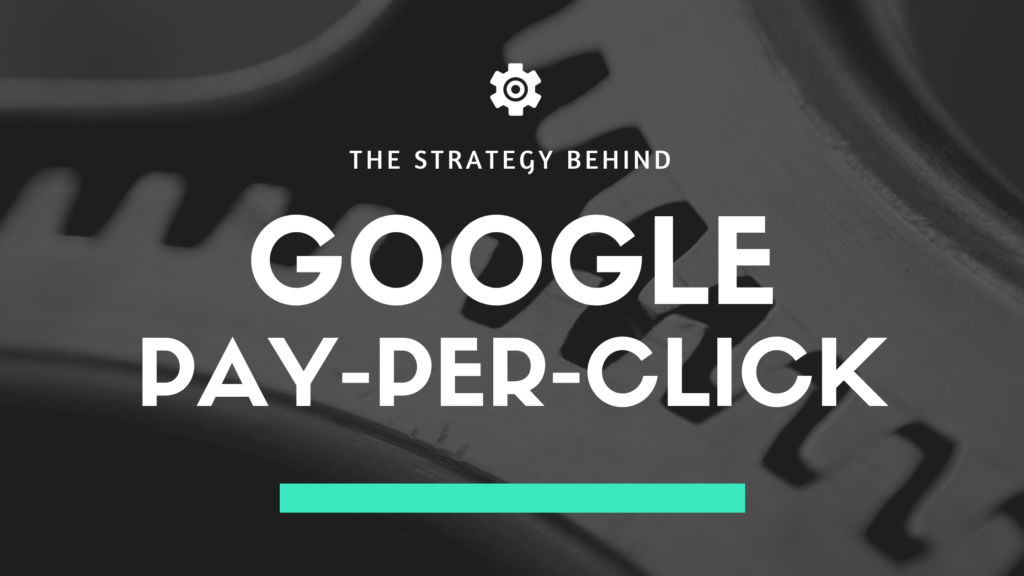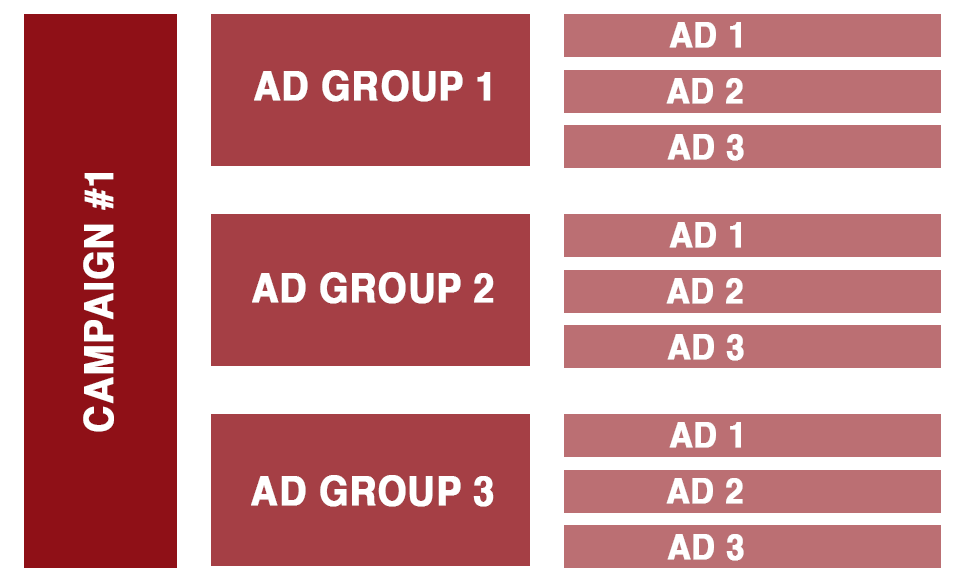The Best Strategy Behind Google Pay-Per-Click
Google, aka Alphabet company, has some of the best and most crucial web services and tools available for individuals, small businesses, or large corporations looking to make a strong digital presence. No matter the size, it is important for any individual or company to capture a large audience reach. Capturing a large audience reach can be done organically or through paid media search & advertising. That being said, organic traffic is certainly the most ideal solution for any business. Although organic traffic is usually perceived as free or cheaper than paid traffic; it is also very time-consuming. Knowing this, organic traffic could lead to a higher cost than paid advertising. Furthermore, perhaps the best solution for any business is a combination of both organic traffic and paid advertising. This is where Google Pay-Per-Click (PPC) comes into play. Every website is unique and ultimately has a message they want to convey or a product they want to sell. However, it is kind of hard to sell a message or product if there is no traffic coming to your website. For those who are looking to increase overall website traffic, it is important to note that the #1 search engine platform used worldwide is: Google.com. For this reason, the majority of your organic traffic will more than likely come from a Google search directly. If this is the case, wouldn’t it make sense to also advertise on Google while you compete organically for that number one google search spot based on the specific keywords that were searched? Of course, it does! Today, we would like to take a deeper dive into Google Pay-Per-Click – aka Google PPC. Some of you might already be doing some form or fashion of Google PPC. Some of you might be doing some other digital advertising with relations to Facebook, Instagram, Youtube, Twitter, LinkedIn, Pinterest, or the countless other social media platforms that are available in today’s market. However, in this post, we are going to focus specifically on Google PPC and the best strategies and practices when setting up your PPC ads. If this sounds like something you are interested in, please follow with us through each step of the process that we have used to set up top-performing PPC ads that have proven to be highly successful. However, if PPC ads are of no interest at this moment in time, please feel free to connect with us about any other inquiries you may have with relation to digital marketing, digital advertising, or marketing automation. We would be happy to earn your trust and help your business grow.
Strategy From Start to Finish
(Please Note****: The strategies represented here do not account for the Keyword Research, Estimated budget based on your Keyword research, avg. Cost Per Click (CPC) or Estimated monthly traffic volume based on keywords searched. This is merely the strategy for setting up Google PPC ads)
Step 1: Setting Up An Account with Google Ads / Google Adwords
What is the difference between Google Ads and Google Adwords? Answer: nothing is different. They are the same thing. Initially, Google called the service Google Ads. They have since updated the name to Google Adwords. Moving on, for you to set up Google Ads, you must first establish a Google Adwords account. It is recommended you set up a Google Adwords account using the email that is associated with your business directly. Once you have set up a Google Adwords account we will need to link your account with your website for the best results. However, before you can begin, you will need an email address and a website for your business. Even if you do not have a website, you can still advertise on Google, using Smart campaigns, the default Google Ads experience for new advertisers. Once you have established a Google Adwords account, sign in to your existing Google Account, or create a new one.
- If you already have a Google Account (in other words, if you use any other Google product, such as Gmail), enter your Google email address and password, then click Sign in.
- If you don’t have an existing Google Account, or want to use a different email address to sign in, just click Create an account at the bottom of the screen and follow the instructions to create and confirm your new Google account.
Once established you are now ready to start setting up your Google PPC Ads.
Step 2: Understanding & Navigating Google PPC
There are so many unique attributes and levels to Google PPC. That said, we are going to give a brief structural overview of the Google PPC platform. The easiest way to think about Google PPC platform is to view the platform as a 3-tier funnel. Those 3 tiers being made up of the following: Campaigns, Ad Groups, and Ads. The top of the funnel (Campaigns) is the broad overview while the bottom of the funnel (ADS) acts as the specifics/what the end-user sees. 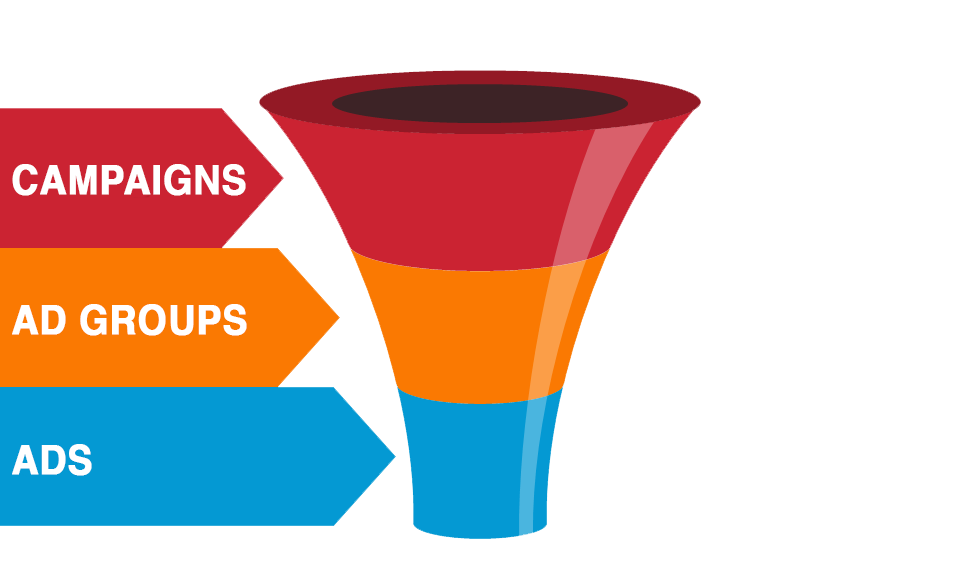 Here is some brief terminology for you when talking about Campaigns, Ad Groups, and Ads.
Here is some brief terminology for you when talking about Campaigns, Ad Groups, and Ads.
-
Campaigns
At the campaign level, this is where you start. You start by naming your campaign. Typically, if you are running an ad for a product or service, you would name your campaign to how it correlates with that product or service. Also, at this level, you would set your overall daily spend/monthly spend. Starting out, you might not have any clue what you should spend. That is ok, as it is a very common question we receive here at Spearhead. Should you need help in direction, strategy, or setting a proper budget; please feel free to connect with us here. As you are just setting up your campaign budget, go ahead and prefill your budget for only $0.01/day. We will come back and adjust the budget once we have our ads built (we expand upon this aspect in the spending section of this post). For now just set it at $0.01/day so you can begin setting up your Ad Groups and Ads. How much money would you like this campaign to spend per day or per month? The budget, ultimately, can be calculated and determined by a culmination of keyword data such as: Avg. Cost Per Click, Avg. Monthly Visits, and Avg. Monthly Search Volume. Additionaly, you will want to know how much traffic and leads are they currently getting. Followed by, how much traffic/leads are you wanting to capture. If you know these factors you can strategically provide a good estimated range for what your company should allocate as daily/monthly spend. For more details, here is a great resource from WordStream: “The Complete, Digestible Guide to Google Ads Budgets”.
-
Ad Groups
This is the 2nd-tier of the funnel. We begin to get more granular at this level. Here is where we will define the overall ‘Campaign’ in more detail. At the Ad Groups level you will decide what specific keywords should be associated with your ads in this specific Ad Group. You will also decide how and when google should show your ad. How? Maybe you would like your ad to show as an image? Or you would like your ad to show as text at the top of related products/services searches? This is where you would tell google what type of ads you want to run. When? You will need to tell Google when you want your ads to appear. In the Ad Groups level, you will select whether you want Google to show your ads on an ‘Exact’ match level, based on when specific keyword/keywords are shown exactly as you have written that keyword/keywords with no additional text; show your ads on a ‘phrase’ match level based on your specific keyword/keywords searched with additional search terms in select order, or lastly let Google show your ads on a ‘broad’ match level based on your specific keyword/keywords but does not have to be exact to your keywords with any additional text. Once you have decided on all of your different Ad Groups, you will want to take the campaign budget you set at the campaign level and decide in more detail, how much of that budget should attribute to each AdGroup. Please note, at this level, there are a lot of customization options you can attribute to the ad group to specify in more detail when you should show your ads such as increasing or decreasing your spend on your cost per click for searches that happen in certain regions or countries. We will go over this in a future post. Please stay tuned. You are now ready to create the final piece of the funnel.
-
Ads
The 3rd and final tier of the funnel. Ads are nestled inside of ‘Ad Groups’, for which, the Ad Groups are nestled inside of ‘Campaigns’. In the Ads portion of the funnel, you will ultimately decide the content that is shown on ads, whether the ad should be an image ad, search/text ad, or a call ad. You will input the text and images you wish to use for the ad. You will also input the URL for which the ad will link to your website. Additionally, if you have different or additional messages you want to promote, you can create multiple ads inside of the Ad Group. For example: maybe you want to show an image ad, a responsive text ad, and a call ad that are all related to your specific product or service, you would create all three of the ads in your Ads bucket. You can then test which type of ads, or what type of messaging for your ads, work best in reach, engagement, and conversions for your company to adjust to maximum budget for the best ads.
Step 3: Setting Up Your Google PPC Ads with Best Strategy in Mind
Our recommended best strategy when creating Google PPC ads can be shown in the above image. As you can see, we start with Campaigns (top of funnel) and move towards Ad Groups (middle of funnel), then followed by Ads (bottom of funnel). This is how we are going to structure our Google PPC ads in this strategic overview. However, we are going to take it to a more technical level. Using the above image structure, we are going to remove the example terminology and replace it with structural terminology. See the following image structure for more details: 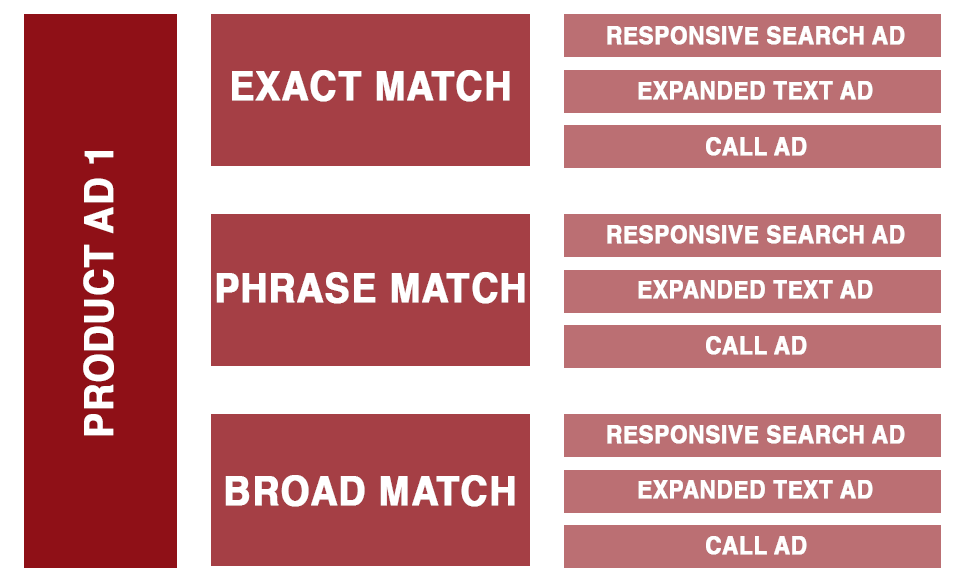 At the campaign level we have named it Product Ad 1. Inside of Product Ad 1 we have three different ad groups. We have done this on purpose because we want our ads to appear in each of the following scenarios:
At the campaign level we have named it Product Ad 1. Inside of Product Ad 1 we have three different ad groups. We have done this on purpose because we want our ads to appear in each of the following scenarios:
1.) Exact Match
Show ads that exactly match the keywords searched. There is no text before, after, or in between the keywords searched.
2.) Phrase Match
Show ads that exactly match the keywords searched. However, There can be text before, after, or in between the keywords searched.
3.) Broad Match
Show ads that have the keywords searched but may not exactly match. There can also be text before, after, or in between the keywords searched.(Note*** when adding keywords to Ad Groups, you only need the singular or plural version of the word, you do not need both. Google is smart enough to show ads for a keyword regardless if the keyword is singular or plural.)
In the beginning, we utilize all of Google keyword match types (Exact, Phrase, Broad) in their own ‘Ad Group’. The reason we do this is so that we can test how our products are best searched. This helps us understand the following question. How do our products get searched? Are they being searched with exact terminology, or are they being searched with additional terms. As time goes on, we will begin to see an obvious trend in keyword searches for our product or service. Once we know the trend on how searches are performed we can readjust our overall campaign to only use one ad group, with tailer ads that relate specifically to the trending keywords. Furthermore, we can address our ads landing page to utilize/capture all of the keywords that are most searched so that Google gives a higher quality score to our ads because our Ad Structure, Ad Group Keywords, and the landing page for our Ads are all aligned properly with what the user searched and the content that is being provided. A higher quality score means your ads will then appear at the top of Google searches more often than at the bottom or another Google page. Knowing this information, you can now start to see why it is very important that you understand your company’s core keywords. What are users searching for with regards to your products or services? Again, we will not dive into the strategy behind finding your company’s core keywords in this blog. If you would like more information on how to find your company’s core keyword information, please connect with us here. If you get a chance, here is a great article to understand why keywords research is very important to your ad success. Now that we have our Ad Groups set up and our proper keywords in place we can move forward in the funnel to creating our Ads. At the Ad level, we want to develop content centralized around our core keywords for the Ad Group. We also want to make sure any image we use has alt text that aligns with our keywords, as well as, aligns with our product or service. As we build out the copy on our ads, we are limited by the number of characters we can use for descriptions and titles. You will have to get creative with well-structured copy that also captures relating keywords. Additionally, the landing page we are going to be sending individuals who take action needs to align with your Ad Copy. Because Google likes to give a higher quality score to ads that align best with your landing page and keywords, it is important that we do not only do a single ad type to start but instead, we should utilize multiple ad types (which means we will have multiple Ads inside of the Ad Group). Here are all of the Ad Types that Google offers: 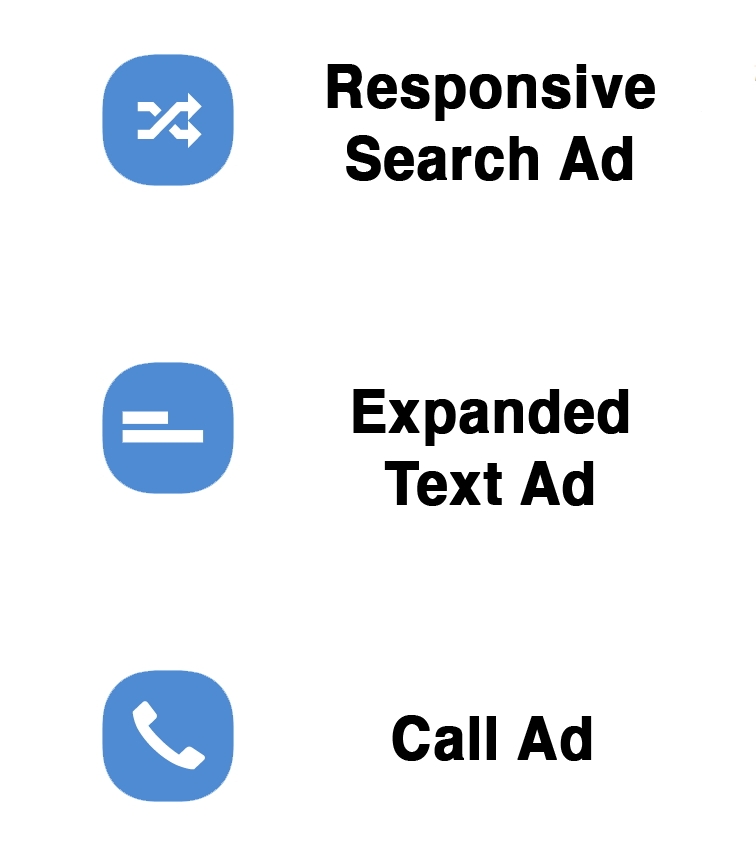
1.) Responsive Search Ads
Dynamically rotate between 15 headlines and 4 descriptions to create the best search ad for your potential customers.
2.) Expanded Text Ads
Drive customers to your website using the next generation of text ads that have a large headline and an extra long description.
3.) Display Ads
Visual banner ads you see on advertising-supported sites everywhere. These are not retargeting ads, but instead, ads that are shown to individuals who have searched for similar keywords to your business at one time or another. Think of the display network as a more passive form of advertising; in comparison to the search network.
4.) Call Ads
An ad click will exclusively drive phone calls to your business. These ads will only appear on devices that can make phone calls
By offering different types of Ad content and Ad structures, we can capture the most opportunities to engage with our audience. Again, much like our Ad Group settings, we will be able to take our data, analyze our data, and begin to restructure our ads by focusing on the ad types that get the best results. In turn, this will allow us to maximize our budget/spend for the best results. Now, since we have three different Ad Groups: Exact, Phrase, and Broad; we will need to recreate all of our Ads and their Ad Types for each Ad Group. You will want to make sure you keep all of your Ads the same as you set them up in each Ad Group. The reason for this is so we can test what Ad Group works best for our overall campaign. From there we can then test, which type of Ads work best for our Ad Group.
Step 4 – Setting Up Budget & Ad Spend
Once we have all aspects of our campaign harmonizing, we can begin to optimize our budget to either represent an increase or decrease in spending based on our most effective product-to-cost analysis. Also known as, how much does it cost per product to advertise. Maybe you find out that as long as you stay under $50 per product sold you can continue running ads. Understanding product cost analysis you can indefinitely increase ad spend, as long as you are hitting $50 of ad spend or less for each product sold. Should you go over that threshold, you know at that point you need to decrease your spending. Keep adjusting the spending until you find that magical sweet spot that optimizes your ad for the least amount of spend and produces the maximum amount of conversions/leads/sales. Speaking of spending, since we have now effectively created our newest ad campaign. Remember back at the beginning of this post we mentioned setting up your campaign initially for $0.01/day. Well, the reason for this is because Google needs to have a budget in place before you can even begin creating Ad Groups and Ads. With our Ad Groups and Ads now complete, we can go back to the ‘Campaign’ level of our Ad and adjust our daily/monthly spend. Again, to determine what your budget/spend should be, there are several ways you can calculate a rough estimate for a start. For sake of this article, we will cover how to calculate Google PPC Ad Spend at a later time. If you need immediate attention, please feel free to connect with us here to talk to our advertising specialist.
That being said, you will want to adjust your budget/spend according to what you have estimated. Once budget/spend is set at the campaign level, Google Ads will automatically spread the campaign budget/spend across each of your Ad Groups. You can manually set how much budget goes to which Ad Group. However, this is not recommended when first starting. Taking it to a deeper level, your Ads inside of each of your Ad Groups will most likely have different spending associated with them. Why? The reason for this depends on several different factors. Does your ad have a high-quality score or a low-quality score? Does your ad relate to the keywords associated with the Ad and Ad Group? Perhaps your cost per click on each keyword is higher than what you are willing to spend and may need to adjust your spending so you can acquire those searches? There are a lot of aspects as to why certain ads perform better than other ads. Please be aware that it is possible for some of your Ads to never spend any budget because they aren’t as quality as other ads or there is not enough spend to reach the keywords in that particular Ad Group. One of the most popular questions we get asked is: “Can you set maximum spend limits?”. Essentially, users want to know if they can set a limit so that if a keyword/keywords cost $15 to get your ad shown but you do not feel comfortable paying more than $10 for a specific keyword/keywords to have your ad shown, you can set a max limit of $10 on your Ad Group so that you never pay more than $10 for your ad to be shown. Again, please know that setting limits can cause ads to never actually be seen if the cost per keyword is higher than $10. If you are still with us on this post, you have just heard us talk about cost per click and maximum keyword bid limit. You might be wondering if there are any other bid strategies that google offers. As a matter of fact, yes! Google offers the following types of Bid Strategies when setting your campaign budget.
Google Bid Strategies Types Overview
1.) Manual CPC (Cost-Per-Click) Bidding Strategy (Not recommend when starting out)
Select this option to bid based on the cost of each click. Selecting to set your bids manually will enable you to take advantage of WordStream’s bidding algorithms.
-
- Enable Enhanced CPC — With Enhanced CPC Google may raise or lower your bids to optimize for conversions. You may choose manual bidding without opting into “Enhanced CPC”.
2.) Automatic Bidding Strategies
- Target CPA (Not Recommend when starting out)
This strategy automatically sets bids to get you as many conversions as possible at your target cost-per-acquisition (CPA). Because this strategy is using an average, some conversions may end up costing more and some may cost less. You can apply this strategy to multiple campaigns, and it’s compatible with both Search and Display campaigns. Note*** your actual CPA may be above or below the target you set.
Eligibility Requirements: You need at least 15 conversions in the last 30 days. However, having more data in the account will allow Google to set bids more effectively.
- Maximize Clicks (Recommended when starting out)
With this strategy, you are giving Google control over your keywords to gain you the most clicks based on your targeted budget. This targeted budget is separate from a daily budget. We recommend setting a CPC bid cap on your bids to avoid spending too much on a click.
- Target Return on Ad Spend (Rarely Used – Not recommended when starting out)
With “Target ROAS“, Google automatically sets bids to help get as much conversion value as possible at the target return on ad spend (ROAS) you set. Some conversions may have a higher or lower return than your target.
- Maximize Conversions (Recommended after running maximize clicks for 2 – 3 months to develop conversion data)
Google automatically sets your bids to help you get the most conversions within your budget.
- Maximize Conversion Values (Rarely Used – Not recommended when starting out)
With “Maximize Conversion Value“, Google automatically sets bids to help you get the most conversion value possible within your budget. This bidding strategy uses historical campaign data and contextual signals to determine the optimal CPC bid at auction time. “Maximize Conversion Value” will attempt to spend your entire daily budget. We recommend reviewing your average daily budget to monitor how much you’re currently spending because this bidding strategy could increase spending significantly. Note*** Having more data in the account will allow Google to set bids more effectively.
3.) Portfolio Strategy (Used on Rare occasions)
Portfolio bid strategies help you optimize bids across multiple campaigns, ad groups, and keywords. With a portfolio bid strategy, bids are automatically set for every auction to help you reach your goals.
4.) Max CPC Bid Limit (Recommended)
You can set a Max CPC so Google will not spend more than what you’d like per click for any keywords, ad groups, or campaigns using this bid strategy
When first starting out, we highly recommend starting with an “Automatic Bid Strategy” using the “Maximize Clicks” option as a starting point. This will effectively get you the most clicks for you to see what keywords are spending and which ones aren’t. This will help build yours in the shortest time frame for you to review and adjust accordingly. As your Ad campaigns continue to get better and more precise over time, you can adjust to a more defined strategy that would be better suited for your Ad Campaign.
Google PPC Strategy Conclusion
Whether you have been running Google PPC ads for a while now or just starting out, properly setting up your Google PPC ads at the foundational level can and will ultimately determine the efficiency and effectiveness of your ads and your ad spend. With a proper Google PPC strategy setup and after doing your upfront homework for your company keywords and estimate budget spend, you can optimize your ads to work for you and not against you. Reach bigger audiences. Capture higher conversions. Spend less on your cost per click. Reduce your average CPA (Cost-Per-Acquisition). All of these can be achieved when following the best Google PPC Ad Strategies. For us, we have found that the best way to achieve all of these is to start broad and constantly adjust according to your data. Over time, our broad look will begin to look more detailed until one day we review our ads and realize how efficient our ad is at converting. The absolute most important aspect when starting out in any ad platform is to understand the word: Patience. It will take patience to properly, accurately, and efficiently optimize your ads. Do not be discouraged if after 2 or 3 months your ads are not seeing the results you would like to see. You might have discouraging numbers, but you also have a lot of unique data that you can now analyze to adjust your ads for the better. Stick with it and you will be a Google PPC Ad expert in no time. If you enjoyed this post or are eager to get started and would like to connect with us at Spearhead Sales & Marketing, we can help lead, guide, teach, and implement successful Ads for your business today. Please connect with us here or fill out the form below for more information in regards to Google PPC Ad setup and implementation with your business, service, or product.
For more information on how to calculate Google PPC Ad Spend be sure to check out our latest blog: “How To Calculate Google PPC Direct Ad Spend” – this is a deep dive on how you can calculate a pretty acurate Google PPC campaign spend.
This blog was written by Spearhead Sales & Marketing, 242 Waterfall Drive, Elkhart, IN 46516.
